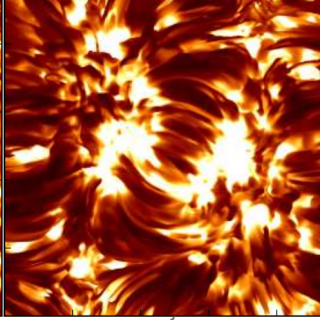Bibcode
Houston, S. J.; Jess, D. B.; Asensio Ramos, A.; Grant, S. D. T.; Beck, C.; Norton, A. A.; Krishna Prasad, S.
Bibliographical reference
The Astrophysical Journal, Volume 860, Issue 1, article id. 28, 13 pp. (2018).
Advertised on:
6
2018
Journal
Citations
40
Refereed citations
38
Description
Chromospheric observations of sunspot umbrae offer an exceptional view
of magnetoacoustic shock phenomena and the impact they have on the
surrounding magnetically dominated plasma. We employ simultaneous
slit-based spectro-polarimetry and spectral imaging observations of the
chromospheric He I 10830 Å and Ca II 8542 Å lines to examine
fluctuations in the umbral magnetic field caused by the steepening of
magnetoacoustic waves into umbral flashes. Following the application of
modern inversion routines, we find evidence to support the scenario that
umbral shock events cause expansion of the embedded magnetic field lines
due to the increased adiabatic pressure. The large number statistics
employed allow us to calculate the adiabatic index, γ = 1.12
± 0.01, for chromospheric umbral locations. Examination of the
vector magnetic field fluctuations perpendicular to the solar normal
revealed changes up to ∼200 G at the locations of umbral flashes.
Such transversal magnetic field fluctuations have not been described
before. Through comparisons with nonlinear force-free field
extrapolations, we find that the perturbations of the transverse field
components are oriented in the same direction as the quiescent field
geometries. This implies that magnetic field enhancements produced by
umbral flashes are directed along the motion path of the developing
shock, hence producing relatively small changes, up to a maximum of
∼8°, in the inclination and/or azimuthal directions of the
magnetic field. Importantly, this work highlights that umbral flashes
are able to modify the full vector magnetic field, with the detection of
the weaker transverse magnetic field components made possible by
high-resolution data combined with modern inversion routines.
Related projects

Solar and Stellar Magnetism
Magnetic fields are at the base of star formation and stellar structure and evolution. When stars are born, magnetic fields brake the rotation during the collapse of the mollecular cloud. In the end of the life of a star, magnetic fields can play a key role in the form of the strong winds that lead to the last stages of stellar evolution. During
Tobías
Felipe García

Magnetism, Polarization and Radiative Transfer in Astrophysics
Magnetic fields pervade all astrophysical plasmas and govern most of the variability in the Universe at intermediate time scales. They are present in stars across the whole Hertzsprung-Russell diagram, in galaxies, and even perhaps in the intergalactic medium. Polarized light provides the most reliable source of information at our disposal for the
Ernest
Alsina Ballester